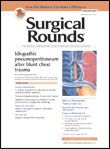Lessons in Critical Care from the Boston Marathon Bombing
Anniversaries often prompt reflection, and the 2013 Boston Marathon bombing is no exception.

Anniversaries often prompt reflection, and the 2013 Boston Marathon bombing is no exception.
Among the many reflective pieces published in the medical literature, one stands out: an 11-page case study featured in the April 2014 issue of the New England Journal of Medicine walked readers through the case of a 34-year-old man who suffered traumatic injury that day.
The patient arrived at Massachusetts General Hospital after undergoing a below-knee amputation of his right leg at the scene. The piece described the decisions made at the bombing site and in the emergency department, including amputation, tourniquet use, concerns that the tourniquet was insufficiently tied, burns, and foreign body complications.
The study provided interesting details on treatment following this type of event. For example, few healthcare professionals realize that when surgeons remove foreign bodies and shrapnel during events like the Boston Marathon bombing, the Federal Bureau of Investigations (FBI) works with the hospital to take possession of amputated limbs and foreign bodies as evidence, so chain of custody is an important concern.
Like many others, this patient developed rhabdomyolysis with creatine kinase levels exceeding 10,000 U/L, a condition that increases risk of acute renal failure. In response, the team used early, aggressive fluid resuscitation and electrolyte substitution to increase renal perfusion and stabilize urinary output.
A key section of the article addressed the multidisciplinary approach to critical care medicine and described exemplary healthcare collaboration. This patient received care from otolaryngology, psychiatry, rehabilitation medicine, and physical therapy specialists. Although he did not show signs of post-traumatic stress disorder (PTSD), the treatment team took every measure to prevent its development. They also dealt with the patient’s intractable pain, sleep disturbances, and quality of life.
The facility used a family-centered critical care medicine model and asked the patient's fiancée, a trained nurse, to participate in daily rounds and stay in the room overnight. The team also spoke daily with the patient’s father, and the patient himself contributed to this study by being present for rounds and answering questions.
However, an intrathoracic foreign body found in the patient was a challenge that required extensive imaging and a careful plan due to its proximity to the heart. Ultimately, the team decided the concerns were not urgent and deferred management. In addition, the case study described the patient’s blast injuries and explained how they differed from other injuries.
Military personnel who had undergone leg amputations visited the patient in the intensive care unit to discuss their successful rehabilitation, which served as an example that fully independent vocational and social functioning was possible and likely. The case study also described the patient’s anger and frustration, despite his relief at having survived the bombing.
Overall, the patient reported that his care was exceptional. When asked what could have been better, he gave an expected yet humorous answer: the food.
